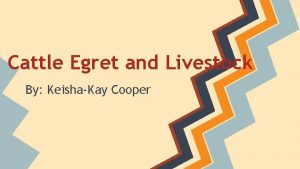Genomic evaluation of Ayrshire dairy cattle and new

- Slides: 1

Genomic evaluation of Ayrshire dairy cattle and new haplotypes affecting fertility and stillbirth in Holstein, Brown Swiss and Ayrshire breeds T. A. Cooper*, G. R. Wiggans, P. M. Van. Raden, J. L. Hutchison, J. B. Cole, and D. J. Null Animal Improvement Programs Laboratory, Agricultural Research Center, USDA, Beltsville, MD 20705 -2350 INTRODUCTION T 206 RESULTS (continued) • Genomic evaluation of dairy cattle in the US has been available for Holstein, Jersey and Brown Swiss since 2009. As of February 2013, there were 1, 100 genotyped Ayrshires in the North American database including 646 bulls with traditional evaluations allowing for the evaluation of this breed. Current effects of new haplotypes on fertility and stillbirth Breed Holstein Brown Swiss Ayrshire DATA & METHODS 1 2 • Gains in reliability due to genomics were determined by comparing parent averages and genomic evaluations from August 2008 to December 2012 daughter performance for bulls born on or after January 1, 2000 who received a traditional evaluation by December 2012. The number of bulls tested ranged between 147 and 180 bulls by trait. • Breed specific SNP were determined by comparing the allele frequencies of Ayrshire genotyped animals to allele frequency found in Holstein, Jersey and Brown Swiss. • Haplotypes affecting fertility were identified by investigating areas of the genome with a lack of expected homozygous haplotypes (Van. Raden et al. , 2011). Chromosome HH 4 HH 5 BH 2 AH 1 1 9 19 17 1 6 29 14 Observed Homozygotes Conception Carrier Matings Conception Decrease (%) Stillbirth Carrier Matings Stillbirth Increase (%) 0 12 0 0 103, 4511 5, 025 964 483 -3. 01 -3. 5 ± 0. 6 0. 3 ± 1. 5 -4. 4 ± 2. 5 N/A 1, 115 1, 307 N/A 0. 7 ± 0. 7 2. 6 ± 1. 3 N/A The reported HH 4 carrier matings and conception decrease are from French data (Fritz et al. , 2013). A genotyped embryo was homozygous and was implanted, but no pregnancy was detected 28 days later. Birth Year Haplotype Carrier Frequency 50 45 40 Current frequencies and primary source of new haplotypes Haplotype Ancestor HH 4 HH 5 BH 2 AH 1 FRA 4486041658 Besne Buck CAN 264804 Thornlea Texal Supreme USA 144488 Rancho Rustic My Design USA 117936 Selwood Betty’s Commander Birth Year Carrier Frequency (%) 1986 1957 1963 1953 0. 7 5. 0 20. 5 26. 1 • Losses in fertility were investigated by looking at the carrier sire by carrier maternal grandsire matings within each breed. Haplotype Carrier Frequency (%) • Four new haplotypes, two in Holstein, one in Brown Swiss, and one in Ayrshire, appear to be simple recessives that should be reported to breeders for use in selection and mating. Haplotype Expected Homozygotes 35 30 25 20 15 10 5 0 before 1960 HH 4 HH 5 1960 s BH 2 AH 1 1970 s 1980 s 1990 s 2000 -2007 2008 to present SELWOOD BETTY'S COMMANDER (b. 1953) Photo: North Eastern Breeders Association RESULTS Observed reliabilities (REL) in August 2008 for traditional parent averages and genomic of young bulls without daughter information, coefficients of determination (R 2 × 100) between August 2008 evaluations and December 2012 daughter deviations deregressed from traditional evaluations, coefficients (b) for regression of January 2012 daughter deviations on August 2008 genomic evaluations, and bias in genomic evaluation by trait DISCUSSION and CONCLUSION evaluations * August 2008 REL (%) Parent Genomic Average Evaluation R 2 Gain Parent Average Genomic Evaluation b Bias*** Trait** N† Milk (kg) 180 35. 0 51. 6 16. 6 0. 15 0. 28 1. 05 ± 0. 13 -87. 8 ± 39. 1 Fat (kg) 180 35. 0 49. 0 14. 0 0. 22 0. 32 1. 01± 0. 11 -2. 8 ± 1. 5 Protein (kg) 180 35. 0 51. 8 16. 9 0. 29 0. 42 1. 17 ± 0. 10 -3. 7 ± 1. 0 NM ($) 180 31. 5 45. 1 13. 6 0. 14 0. 23 1. 26 ± 0. 17 -50. 3 ± 33. 2 PL (mo) 171 26. 1 30. 3 4. 2 0. 07 0. 10 1. 16 ± 0. 27 -0. 3 ± 0. 4 SCS 180 30. 5 33. 5 3. 0 0. 22 1. 01 ± 0. 14 0. 0 ± 0. 0 DPR (%) 147 27. 9 28. 0 0. 15 1. 01 ± 0. 20 0. 0 ± 0. 2 Final Score 175 26. 2 26. 1 -0. 13 1. 00 ± 0. 19 -0. 1 ± 0. 1 Stature 177 31. 3 47. 5 16. 2 0. 23 0. 36 1. 03 ± 0. 10 -0. 3 ± 0. 1 *Includes SNP and polygenic effects estimated from the August 2008 predictor population (genotyped animals with traditional evaluations) and August 2008 traditional parent averages. = net merit, PL = productive life, DPR = daughter pregnancy rate and SCS=Somatic Cell Score. ***January 2013 daughter deviation – August 2008 genomic evaluation. †Number of validation bulls (received traditional evaluation by January 2013) Genomic REL – parent average REL. ** NM Ayrshire Milk SNP Effects Holstein Milk SNP Effects • The average gain in reliability over parent average for all traits was 8. 2. The highest gains were found in milk yield (16. 6), protein yield (16. 9) and stature (16. 2). • SNP with the largest effects vary between Ayrshire and Holstein. These evaluations were calculated based on the North American population and may not be suitable to all red dairy cattle because linkage disequilibrium probably differs by population. • There are 12 SNP in Ayrshire that can be used for breed determination because they are nearly monomorphic (>90%) in Ayrshire and have fewer than 30% of animals homozygous for that allele in Holstein, Jersey and Brown Swiss. There are fewer breed determining SNP in Ayrshire than in Holstein, Jersey and Brown Swiss, mostly due to the similarity of Ayrshire and Holstein. • The frequency of HH 4 carriers is 7. 2% in France (Fritz et al. , 2013) and could also be high in other countries that used many sons of Jocko Besne, a prominent carrier. • The effect of BH 2 on stillbirth is similar in size to the previously known defect Spinal Muscular Atrophy (SMA). The fertility losses from HH 5 were estimated to all occur before 60 days of gestation; no estimates for HH 4 and AH 1 are yet available. REFERENCES Fritz S, Capitan A, Djari A, Rodriguez SC, Barbat A, et al. 2013. Detection of haplotypes associated with prenatal death in dairy cattle and identification of deleterious mutations in GART, SHBG and SLC 37 A 2. PLo. S ONE 8(6): e 65550. Schwarzenbacher, H. , Fuerst, C. , Fuerst-Waltl, B. and Dolezal, M. 2012. A genomewide search for harmful recessive haplotypes in Brown Swiss and Fleckvieh cattle. Proc. EAAP annual meeting, Bratislava. Van. Raden, P. M. , Olson, K. M. , Null, D. J. , and Hutchison, J. L. Harmful recessive effects on fertility detected by absence of homozygous haplotypes. J. Dairy Sci. 94(12): 6153 – 6161. 2011. Van. Raden, P. M. , Null, D. J. , Olson, K. M. , and Hutchison, J. L. Reporting of haplotypes with recessive effects on fertility. Interbull Bull. 44: 117– 121. 2011. ACKNOWLEDGMENTS The authors thank Jacques Chesnais and Nicolas Caron (The Semex Alliance, Canada) for information on the homozygous HH 5 embryo and for genotyping the earliest source ancestor, Hermann Schwarzenbacher (Zucht. Data EDV-Dienstleistungen Gmb. H, Austria) for information on BH 2, Dan Gilbert (New Generation Genetics) for informing us of the Austrian research, and Didier Boichard for information on HH 4. http: //aipl. arsusda. gov

